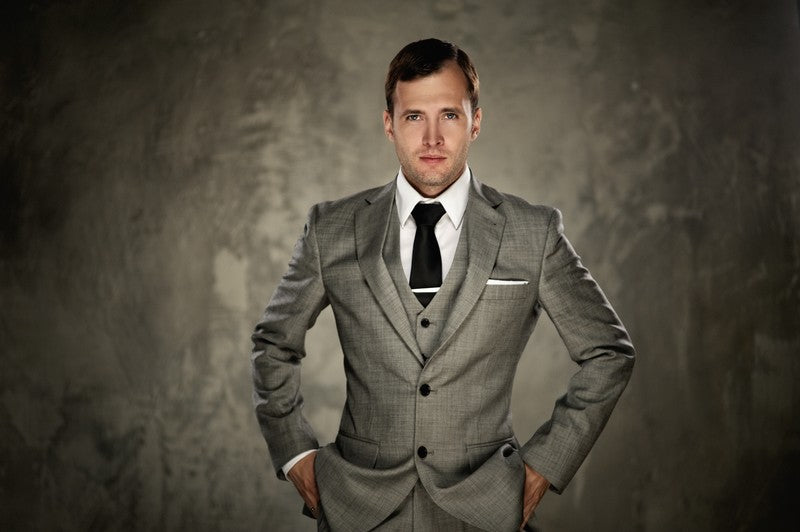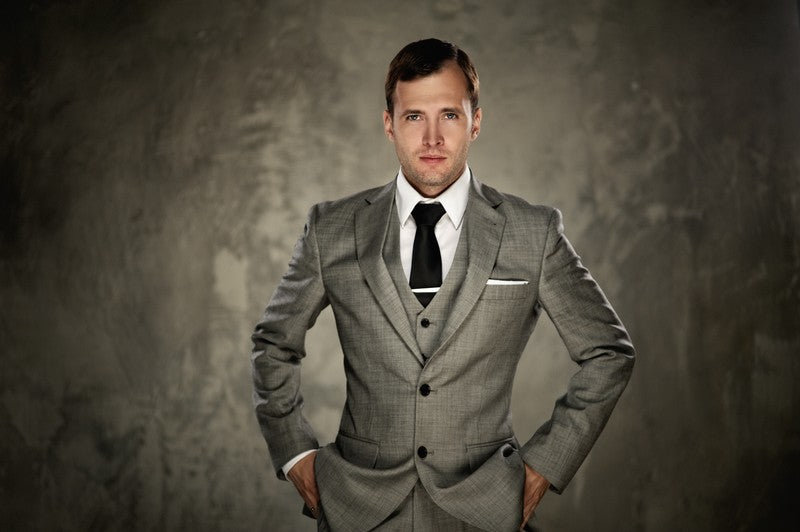How to Buy a Man’s Business Suit

In this day and age, business attire ranges from casual to formal. This means that anything from khaki trousers to a three piece suit is acceptable in the work force. What a man decides to wear to work depends entirely on the position he holds, the company he works for, and what social functions he can be expected to attend throughout the year. Even if a suit is not required for work, it is more than likely that every man will need to wear a suit at least once in his lifetime. If a man wears the wrong suit, or one that is poorly cut or styled, it will reflect negatively on him, and very quickly leave the wrong impression. This article is going to look at the basics of buying a business suit. Here you will find how to choose the right fabric, cut, and pieces to consider when buying a suit. If you have never bought a suit but think you might, this article will give you some practical tips to consider when doing so.

Fabric
The key factor in determining a suit’s quality is the fabric it is made of. There are some definite things to consider that will either make or break the image you project when you wear your suit. The color of your suit is very important, and there is a definite trend in what color to wear. Color is a key point when choosing your fabric and knowing your color ahead of time will help you narrow down your specific fabric choice. You will want to start with navy, then go to grey, and then move to khaki or camel colors. The reason for this is regardless of how fashion trends have changed, the standard navy suit is always a classic and is the most appropriate color for any occasion either social or formal. Once you have added the navy suit to your wardrobe, consider moving to the other colors if you intend to wear suits often.
Wool is the most popular fabric to consider for your suit, and the type of wool you are looking for is worsted wool. This is the best quality, and the most durable suit fabric. Wool fabric in suits is going to say on the label tweed, flannel, or worsted wool. These are all good quality fabrics for your suit. Any term that has the word “twisted” in it on the label simply refers to how many times the yarn or the wool was twisted. A higher number near twisted wools will indicate a higher quality fabric. The last thing you should do when examining your suit fabric is to crumple it. The fabric should bounce back and not wrinkle. If you see wrinkling, you are looking at either a linen suit or a poor quality fabric. Wool fabric is going to be the most expensive, so if you are on a budget, look for a wool blend to accommodate the price difference. This will still provide some of the quality while not affecting the pocketbook too much.

The fabric you want to avoid is anything that is polyester. You want to stay away from polyester suits all together as they have a tendency to look cheap and they do not breathe well. Polyester fabrics are going to have names and terms like micro fibers and Teflon. You definitely want to avoid any labels that say those names. When you perform the crumple test on polyester, you will get some definite crinkling.
Linen fabrics are a great choice for suit wearers, but if you are only going to buy one suit, go with the wool fabrics. Anything made with linen is going to be a lighter fabric and is more suitable for the warmer seasons or climates. The disadvantage to linen also is that it will crumple, and will cost you more in dry cleaning.
Cut
The cut of your suit is the next decision you will have to make. There are three main types of suit cuts. First is the American cut and is the most standard. This is the suit cut you see most people wearing. Full cut is the second choice. Here you will not see any tapering at the waist. The jacket will hang straight down and allow more waist room. The last type of cut is European cut. This is a very trim and tapered look and is not commonly worn in American styles. Any suit that you will buy is going to be tailored regardless of your budget. Your tailor will generally know what he is doing, but he will ask you what look you are going for, so be prepared to have an idea of the cut you want.
Pants
 The key to your decisions regarding what pants you choose will be dependent entirely on what look you are going for. If you want something formal, you will want something with pleats in the front. This is a standard dressy look in suits. If you want a thinner look, you can opt for a flat panel front, as these tend to be the most slimming. Whether or not you will have cuffs again depends on your look. Cuffs tend to be more formal, but they shorten the leg. Uncuffed pants are less formal, but will elongate your leg. Your cuffs should not be any longer than 1” long, and your tailor will ensure this. Your pants should sit comfortably on the waist, and not on the hips. You should be able to slide two fingers in your waistband between the pants and the stomach comfortably. When you walk, you want them to drape slightly over the tops of your shoes, and your socks should not be visible. If you are buying your suit off the rack as opposed to designer label, you may end up with whatever pants come with the jacket. If this is the case, the fit of the jacket is more important than the fit of the pants
The key to your decisions regarding what pants you choose will be dependent entirely on what look you are going for. If you want something formal, you will want something with pleats in the front. This is a standard dressy look in suits. If you want a thinner look, you can opt for a flat panel front, as these tend to be the most slimming. Whether or not you will have cuffs again depends on your look. Cuffs tend to be more formal, but they shorten the leg. Uncuffed pants are less formal, but will elongate your leg. Your cuffs should not be any longer than 1” long, and your tailor will ensure this. Your pants should sit comfortably on the waist, and not on the hips. You should be able to slide two fingers in your waistband between the pants and the stomach comfortably. When you walk, you want them to drape slightly over the tops of your shoes, and your socks should not be visible. If you are buying your suit off the rack as opposed to designer label, you may end up with whatever pants come with the jacket. If this is the case, the fit of the jacket is more important than the fit of the pants
Jacket
 Lapels are a must in today’s suit trends, regardless of how popular the Miami Vice look may have been. Whether you have high or low notches does not matter, as long as they aren’t too big and lay flat on your chest. You also want to see a lot of stitches around the outside of the lapel that are almost invisible. The collar should lie flat against your back and leave room for ¼” of collared shirt underneath in the back. A two or three button jacket is good, and you always want to leave the bottom button undone. The shoulders should be slightly padded as this makes the suit hang properly, and they should not give a boxy or sloped look. Sleeves need to leave room for ¼” to ½” of shirt sleeve and fall about 5” above the tip of your thumb. Button the jacket and sit down. The jacket should not bunch up. The difference between either single or double breasted jackets is simply that in a single, the jacket simply buttons instead of folding itself over in front as in double breasted. What style you select will depend on both your budget and your body type, which this article will explore next.
Lapels are a must in today’s suit trends, regardless of how popular the Miami Vice look may have been. Whether you have high or low notches does not matter, as long as they aren’t too big and lay flat on your chest. You also want to see a lot of stitches around the outside of the lapel that are almost invisible. The collar should lie flat against your back and leave room for ¼” of collared shirt underneath in the back. A two or three button jacket is good, and you always want to leave the bottom button undone. The shoulders should be slightly padded as this makes the suit hang properly, and they should not give a boxy or sloped look. Sleeves need to leave room for ¼” to ½” of shirt sleeve and fall about 5” above the tip of your thumb. Button the jacket and sit down. The jacket should not bunch up. The difference between either single or double breasted jackets is simply that in a single, the jacket simply buttons instead of folding itself over in front as in double breasted. What style you select will depend on both your budget and your body type, which this article will explore next.
Budget and Body Type
While it may not seem these are very relevant issues in relation to each other, both factors will determine what suit you can buy. A double breasted suit is going to cost a little bit more, but is better for some body types than others. As it tends to add a boxy bulky look to a suit, it is more suitable for taller and thinner men. Even if your budget allows it but you do not fit the category, stay away from double breasted. Shorter and fuller figured men will want to go with shorter length jackets that are single breasted, and you will want to go with dark solids rather than pinstripes. Shorter men will also want to go uncuffed in the pants to elongate the look of their leg. Thinner and taller men are going to want to go just the opposite direction, and should go with cuffed pants for shortening effects, and a double breasted jacket to add some upper body bulk.
Accessories
 The only thing you need to worry about with this is to have a belt that is going to match the shoes you intend to wear. Leather is the preferred material here, and matching the colors is the key to good accessorizing.
The only thing you need to worry about with this is to have a belt that is going to match the shoes you intend to wear. Leather is the preferred material here, and matching the colors is the key to good accessorizing.
These are your suit buying basics. In order of importance you are going to consider fabric, cut, and body type when making your suit decisions. A suit with a good quality fabric but a poor cut is still going to fare much better for you than a suit with polyester makeup. Choose a well known retailer in your area when making your purchase and any salesperson worth their salt will be able to help you make these choices specific to your needs.
More Readings: